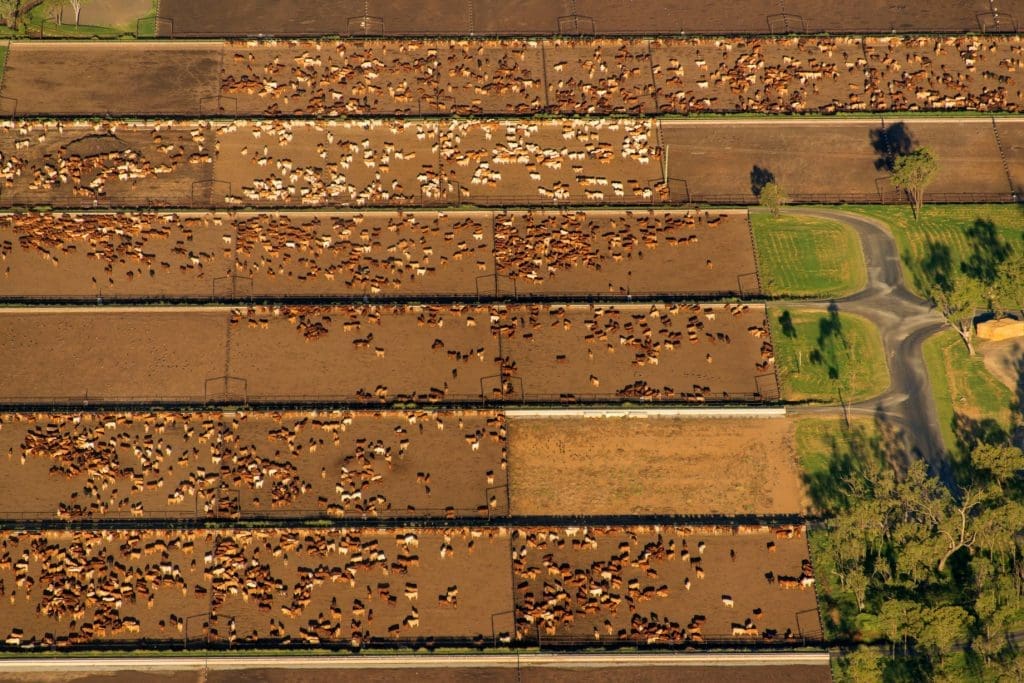HISTORICALLY, the valuation of a feedlot has never been a straightforward exercise, as it is necessary to consider many issues including licenced and current development capacity, access to water, and staff and support infrastructure.
However along with water, location is perhaps the most important aspect that a buyer – whether they be a corporate or a small private family – has to consider, according to valuer Doug Knight, a feedlot specialist with Herron Todd White.
“It is no fluke therefore that the biggest concentration of feedlots in Australia is positioned on the inner Darling Downs of southern Queensland and north-eastern New South Wales,” Mr Knight said in a recent monthly property review.
“This region is ideally positioned in a direct line from a company’s western or northern holdings to their end destination of the meatworks in the east.”
The Downs is known for its consistent climate that normally allows for a multitude of feed-related crops to be produced, high-quality support lands, good staff accessibility and reliable water rights that underpin such an operation.
Since about 2000, the market began to view feedlots as something more than “just an opportunity conditioning facility,” Mr Knight said.
“As a result we saw a rush of sales occur from about 2004 to 2007, coupled with expansion of operations through to about 2011 as both corporate producers and processors (in the main) rushed to shore-up their supply-chains.”
At about that point the sector reached a stage of equilibrium where supply broadly met demand, as confirmed by the trend in feedlot occupancy rates during that time, he said.
This lasted until about mid-2014 when demand for Australian beef began to outstrip supply, and when combined with the rapid onset of drought across eastern states, as a result, feedlot occupancy rates began to soar.
Mr Knight said there was only limited sales evidence at valuers’ disposal prior to late 2014, but based on what sales that did occur, it supported a general market range of between $350/Standard Cattle Unit* and $850/SCU plus land and structures outside of the feedlot footprint.
“However to place this in perspective, the majority of these sales were either smaller basic family operations with no potential for expansion; larger-scale dated facilities that needed quite substantial works; or the purchaser paid well in excess of a sustainable level of value for them,” he said.
No significant sales for 20 years
Up until 2014, no modern large-scale feedlot operation in Australia had sold within the previous 20 years, Mr Knight said.
“Valuers therefore had to largely follow their reading of the market when it came to interpreting a value for a feedlot during that period.
Post Mid-2014: Where do Values Sit Today?
With the benefit of hindsight, demand for feedlot assets started to emerge in late 2014 and early 2015 with the sale of Charlton feedlot in Victoria (July 2014).
At the time it was initially thought that this may have been a one-off, however over the course of the past 12 months, this sale has been followed by the sales of Opal Creek feedlot in Southern Queensland (May 2015), Myola feedlot in Northern NSW (July 2015) and Sapphire feedlot (December 2015) near Goondiwindi.
“These feedlots were larger-scale, better-quality facilities that presented themselves as perfect evidence for a valuer and subsequently confirmed the underlying upward momentum of the industry,” Mr Knight said.
“The well-established feedlot is now viewed as a critical component of any larger-scale integrated paddock-to-plate beef operation.”
The evidence gleaned from these sales had now established suitable industry benchmarks for the various types of operations, and now broadly supported value ranges from $400/SCU to $1000/SCU for the feedlot infrastructure itself depending on quality, location and density, Mr Knight said.
“Over the past 12 to 18 months we have seen seven sales at various locations and of varying sizes and condition. Such a turnover of feedlots has not been seen for many years. The current mood is positive, something that has been missing for about ten years,” he said.
“Further it is expected that more transactions may occur over the course of the next 12 months or so, as companies strive to capitalise on the new found confidence underpinned by the grazing sector in general.”
“At this point it is wise to provide some caution, and therefore not to get ahead of the game, however,” Mr Knight said.
“To date, we have not seen any evidence that has dramatically changed our interpretation of the value of a feedlot. Rather, it has largely confirmed our historical belief of where we have seen values position themselves. Therefore we don’t expect to see values significantly increase any time soon. However the beef industry in general has continued to mature, with the depth of the market broadening significantly over the past ten years or so.
“Interest from foreign entities for our beef assets including feedlots has not been at this level for many years, and therefore with new money coming into the country on a daily basis, the potential for the prospective buyer to not fully inform themselves of the current market has never been greater.”
* A Standard Cattle Unit is a benchmark used in some, but not all states to rate feedlot capacity. An SCU is a based on an ‘average’ beast of 600kg liveweight. What that means is that for domestic-weight feeders, considerably more cattle of lighter weight can be fed in the same facility.

